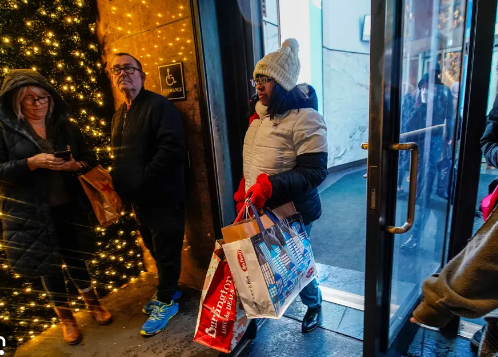Holiday sales in the US increased by 7.6% despite the inflationary strain.
According to one metric, holiday sales increased this year as American spending held steady over the crucial shopping season despite rising prices for everything from food to rent.
According to Mastercard SpendingPulse, which records all types of payments, including cash and debit cards, holiday sales increased 7.6%, a slower rate than the 8.5% increase from a year earlier when consumers started spending the money they had saved during the early stages of the pandemic.
A 7.1% increase was what Mastercard SpendingPulse had anticipated. The report, announced on Monday, does not account for inflation, which has partially subsided but is still excruciatingly high, and excludes the automotive sector.
Clothing rose 4.4% by category, whereas sales of jewelry and electronics fell by almost 5%. Online sales increased by 10.6% over the previous year, and in-person purchases increased by 6.8%. Over 2021, department stores only saw a modest 1% rise.
Spending at restaurants and on clothing drove sales in the United States between November 1 and December 24, a crucial time for merchants.
The former CEO and chairman of Saks and senior advisor to Mastercard, Steve Sadove, stated in a prepared statement that “this holiday retail season looked different from years past.” Retailers offered steep discounts, but customers spread their Christmas buying to account for growing costs and a post-pandemic desire for new experiences and festive gatherings.
The impact of rising costs overall was seen in some of the rises.
Nearly 70% of all economic activity in the United States is generated by consumer spending, and since the first surge in inflation almost 18 months ago, Americans have remained resilient. However, as the cost of essentials consumes a larger and larger portion of everyone’s take-home pay, cracks have started to appear.
Although it has decreased from the four-decade high it hit this summer; inflation is still robbing people of their purchasing power. After reaching a height of 9.1% in June, prices increased by 7.1% in November from a year earlier.
Overall spending has decreased since the pandemic-related splurges and has shifted less toward non-necessities like technology and furniture and more toward necessities like food. Private-label products have been increasingly popular among consumers since they are often less expensive than national brands. They have been frequenting discount retailers like Walmart and chain dollar stores.
Additionally, shoppers awaited sales. Compared to a year ago, when people started shopping earlier owing to a global supply chain disruption that resulted in thousands of product shortages, retailers anticipated a higher number of procrastinators to visit stores in the final few days before Christmas.
According to Katie Thompson, the director of consulting firm Kearney’s Consumer Institute, “consumers are seeking to spread out their budget and are evaluating and purchasing at different retailers.”
Shoppers significantly reduced their retail expenditure in November compared to the prior month. The government reported that retail sales dropped 0.6% from October to November in mid-December, following a high 1.3% increase the previous month. Retailers of furniture, electronics, and home and garden products also experienced a drop in sales.
When the National Retail Federation meets next month, the country’s largest retail trade group releases its combined two-month results based on November-December sales numbers from the Commerce Department, a more comprehensive picture of how Americans spend their money will become available.
Compared to the 13.5% growth of a year ago, the trade organization anticipates that holiday sales growth will decrease from 6% to 8%.
Analysts will also scrutinize major retailers’ financial results for the fourth quarter in February.



